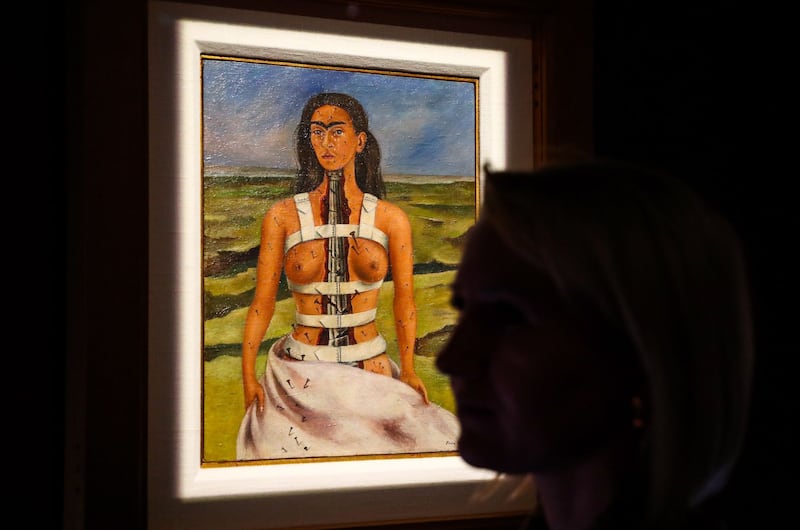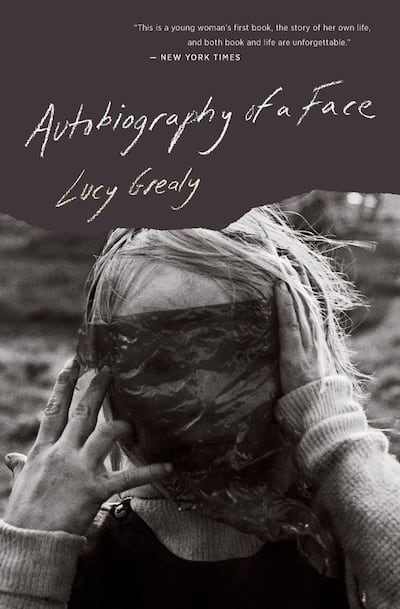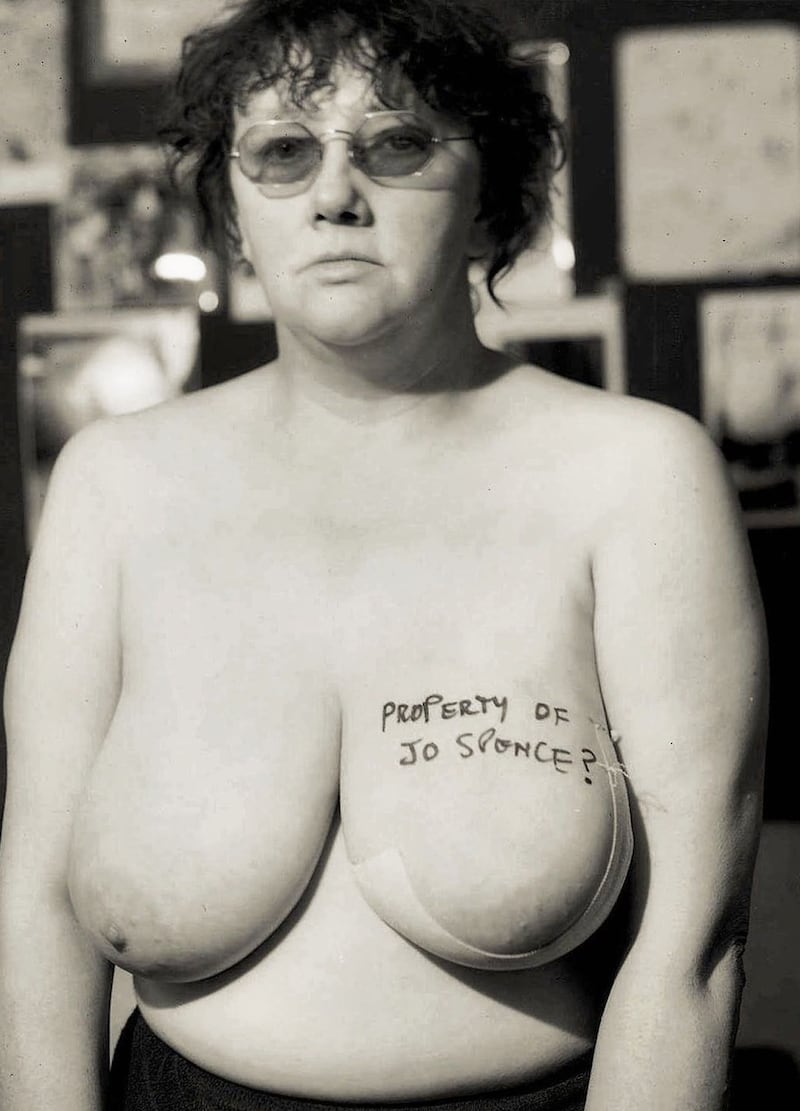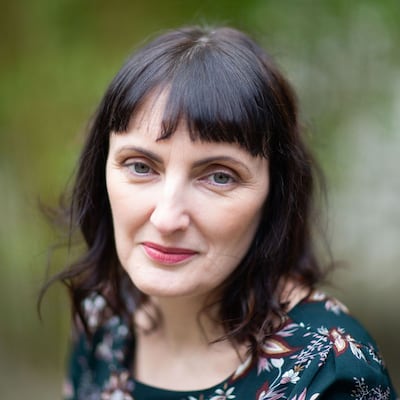Illness is an outpost: lunar, Arctic, difficult to reach. The location of an unrelatable experience never fully understood by those lucky enough to avoid it.
My teenage years were filled with hospitals and appointments, calendars circled with dates for surgery. The arrival of unfamiliar objects under skin. This malfunctioning version of me was a new, treasonous place. I did not know it; I did not speak its language.
The sick body has its own narrative impulse. A scar is an opening, an invitation to ask: “what happened?” So we tell its story. Or try to. To escape illness or physical trauma, we turn to other forms of expression.
It can feel necessary. Art, for some, becomes a source of distraction, a welcome focus to blot out the boredom that comes with this new patient life. I gravitated towards writers and painters. People who told the stories of their illness; who transformed their damaged bodies into art.
WHEN SHE WAS 18, a bus accident changed Frida Kahlo's life forever. Surgeons who initially treated her didn't think she would survive her injuries – a fractured pelvis and collarbone, broken ribs, a broken leg and a mangled foot. Her spinal column shattered in three places, a triptych of bone.
Over the course of her life, Kahlo had more than 30 operations, including the amputation of her leg at the knee. Grappling with childhood polio had been bad enough, but the accident and its effects were catastrophic, and her pain was chronic.
Kahlo married Diego Rivera in 1929, when she was 22 and he was 42. Their connection was founded on art and politics, volatility and attraction. For all his support of her work, and the omphalic nature of their bond, Rivera could not put himself in Frida’s place; her suffering was hers alone. Pain, unlike passion, has no commonality with another being, no shareable fragments.
My admiration of Frida Kahlo has always been about the work; the transference of her life on to canvas, the self-reflection, the engagement with the taboos of illness and the female body
I found Frida during my teen hospital years. Our health issues differed vastly; hers were debilitating in a way that horrified me. I didn’t dare equate her suffering with mine, but our experience felt kindred. My admiration of Kahlo has always been about the work; the transference of her life on to canvas, the self-reflection, the engagement with the taboos of illness and the female body.
In 2005, I went to see a major retrospective of her paintings at the Tate Modern in London. To wander from room to room was to be confronted with several versions of Frida. The multiplicities of her: as artist, as woman, as patient. On every wall was a different her.
I stood rooted to the spot in front of her painting The Broken Column. In it, a huge opening runs through Kahlo’s torso, revealing her ruptured spine. Instead of bone, it is depicted as an Ionic column, an indication of Kahlo’s stoicism. Hundreds of nails are embedded all over her and tears run down her face.
The painting is not just a representation of pain; it physically epitomises it. Whenever I see it I almost wince, complicit in the sensation it evokes.

The twisted bones, the diminished sense of self: I connected with Kahlo. Every night before surgery, after every postanaesthetic fug, every needle or puncture wound, I thought of her. The sense of a body that refuses to keep up its end of the bargain.
In 2018 I saw another Frida exhibition, but this one, at the Victoria and Albert Museum in London, focused on objects from her life. There were clothes, make-up and books. But I was really there to see the detritus of her medical life. In one room I suddenly found myself looking into a glass case of her plaster casts and surgical corsets.
Unexpectedly, I felt tearful. My mind pulled up the image of my own plaster cast, from years before; of feeling miserable and immobile, wondering how permanent the effects would be.
For the months I was sealed into my hip spica plaster I thought of it as a tomb, but Frida saw possibility in hers. She decorated it, the closest she ever came to using her physical self as a canvas
After the bus crash, in 1925, doctors placed Kahlo in a body cast to help her bones heal. It fulfilled its medical purpose but was, to Frida, a prison. Bored and confined, she began to paint. As Frida was unable to sit, her mother bought her a special easel, and, later, a mirror was positioned above her bed so that she could paint herself.
A medical cast is one way of obscuring the body, but Kahlo tried to capture the self that was hidden beneath. For the months I was sealed into my hip spica plaster I thought of it as a tomb, but Frida saw possibility in hers. She decorated the plaster and painted an ornate dragon on her red prosthetic leg, the closest she ever came to using her physical self as a canvas.
In the months after her accident, Kahlo took refuge in painting – but what if there had been no collision? If Frida had been somewhere else on the day of the crash, would she still have become a painter? Her plan, before discovering art, was to become a doctor.
Immobility is gasoline for the imagination: in convalescence, the mind craves open spaces, dark alleys, moon landings. Her paintings are a lesson in corporeal panic and body-in-peril; a way of communicating pain to those unversed in it. Illness and art may be subjective, but when I first encountered Kahlo’s paintings, they represented exactly what I felt, in a way my teenage self could not describe.
WHEN LUCY GREALY'S health began to dominate her life, she immersed herself in writing to express her situation. Born in Ireland in 1963, she relocated to the United States with her family soon after. Aged nine, she was diagnosed with Ewing's sarcoma, a rare facial cancer that required the removal of most of her jaw and three years of chemotherapy and radiation.
By the time Grealy was in her mid-20s – and on her way to becoming a feted writer – she’d had close to 30 operations (the same number as Kahlo). Ongoing surgery was a battle, a fight with her own face. The regularity with which doctors opened her up with scalpels, removed bone and grafted skin took its toll. It was highly invasive, and because the site of the disease was her face there was no question of privacy. There was no way to hide this part of herself from the world: her face, sutured and scarred, was on constant display.
Illness was a burden, her deformity inescapable, but this was not the worst aspect of her experience. In one frank interview Grealy admitted: “It was the pain from that, from feeling ugly, that I always viewed as the great tragedy in my life. The fact that I had cancer seemed minor in comparison.”

The confidence in her writing contrasted with the insecurity prompted by her postsurgical face. Autobiography of a Face was also the only book that spoke directly, intently to me about the self-consciousness that physical illness brings, especially at a young age.
Grealy evokes the physicality of scars, of imperfection, but she also captures the loneliness – the aloneness – of illness. She recalls that no one – doctors, teachers – ever asked about what she was going through, or how she felt.
In her writing, Grealy examined her surgeries from every angle. Medical intervention involves contact and tactility; interaction with doctors, nurses, porters. Intrusive to many patients, but to Grealy a form of connection: an acceptance of help and a means of gaining attention. “It wasn’t without a certain amount of shame that I took this kind of emotional comfort from surgery: after all, it was a bad thing to have an operation, wasn’t it? Was there something wrong with me that I should find such comfort in being taken care of so?”
Perhaps writing offers more cover than art – there are thousands of words to hide behind. In writing, unlike painting, the writer does not explicitly put the body on display. Words are fig leaves, a modesty patch on the nakedness of the ill body. Frida seemingly left no part of her physical self unexplored on canvas. Is paint or sculpture more distancing than having to take a photo of ourselves?
The form of the modern self-portrait has evolved, the months of labour in an oil painting now expedited in a selfie. Would Kahlo have rejected the instant nature of such instant images? That a photo, taken in one second, cannot represent months of pain. That layers of oil and reworked brush strokes hold something more of the experience.
IN USING HER BODY as subject, the photographer Jo Spence (1934-92) was absolute. The decision to point the lens at herself was directly linked to her health.
After a diagnosis of breast cancer, Spence made it the subject – the very centre – of her work, documenting her body, pre- and postsurgery.
In such a confined space, having strangers flank a hospital bed is oppressive. There is no privacy, rarely greetings. These team visits used to frighten me so much. I was present but not invited to be part of the discussion
In The Picture of Health? (1982-6), her collaborative series with the artist Terry Dennett, there is a particular image that makes my heart race. Taken on a hospital ward, at a slight remove, it is a patient’s-eye view from a couple of beds away. The camera is trained on a group of doctors crowding around the bed of a patient. In medical attire, uniformly white, they are indistinguishable from each other.
There may be safety in numbers, but in a hospital scenario it has the opposite effect. The result evokes a sense of threat. In such a confined space having strangers flank a bed is oppressive. There is no privacy, rarely greetings. Those who talk are brusque; those who don’t simply stare, impassive, committed to the medical narrative being explained to them. These team visits used to frighten me so much. I was present but not invited to be part of the discussion.
Spence is mostly known for her photography, but she also used words to create montages. Her photonovel Cancer Shock includes images of her medication and surgical wounds, and they are an attempt to retain control and assert agency. “I want,” she said of Cancer Shock, “a record of my mutilated body in sharp, stark, medical style.”
I related to her mission when I first encountered her work as part of a group exhibition in Ireland entitled Living/Loss: The Experience of Illness in Art. I wrote about the show, and my own life seeped into the piece.
I realise now that it was the beginning of self-investigation into my own illness, prompted by Spence’s images. The Picture of Health? includes one of her most famous photographs. Taken the night before a lumpectomy, she stands naked from the waist up, expressionless, but staring directly into the camera. On her left breast are the words – and an insistent, utterly necessary punctuation mark – Property of Jo Spence? It is an unwavering attempt at reclaimation.

Acts of resistance came naturally to Spence, who never called herself an artist, preferring her own definition of “cultural sniper”. A blurring of lines between public and private, subject and object. Like Cindy Sherman’s, her work is photographic autobiography, but where Sherman dresses up and re-creates exaggerated versions of womanhood, Spence uncovered herself, paring back to an unadorned real woman dealing with disease.
Her work is anti-camouflage, anti-victimhood. Being a statistic within the public health system objectified and dehumanised her, and inspired her to push back. “Eventually I began to see the body as a battlefield,” she wrote.
It is difficult for a female artist within patriarchal culture not to be subsumed by it: fetishised, feminised, sexualised. Kahlo was recently immortalised as a Barbie doll: her skin lightened, her body made symmetrical, her disability – and ethnicity – airbrushed.
Ahead of the V&A exhibition, one woman journalist wrote of her: “Her self-portraits are decorative, but never fussy. Like any great brand, she has an image that is almost childlike in its simplicity,” comparing her famous eyebrows to the Nike swoosh. This co-opting of Kahlo wilfully misses the fundamentally radical representation of herself and her identity in her work.
If people do not see themselves represented in a culture, there is an urgency to create that space. As an ageing, sick, working-class woman, Spence craved a version of art for her, and women like her
A significant motivation for many artists, and particularly Spence, is visibility. If people do not see themselves represented in a culture, there is an urgency and need to create that space. As a woman, and an ageing, sick, working-class woman, Spence craved that representation. A version of art for her, and women like her.
Just as I think of Kahlo before each of my surgeries, Spence’s photos rise up in my mind: the circled pack of doctors, the writing on flesh. Back on a busy ward, pre-meds taken, the familiar gown on, I have an “L” in a circle drawn in marker on my skin by a nurse, to identify the correct leg. Temporary marks ahead of stitches that will one day fade but never disappear. I think of this act as a kind of artistic process: art as instruction and direction.
Last year, ahead of a mammogram, ultrasound and needle aspiration, a doctor drew circles around the cysts in my breasts. On the screen they looked like hailstones, or comets.
IN EXPLORING LUCY GREALY'S writing, there is a sense of embracing excess, of never holding back or turning away from the unconfrontable.
In Kahlo, there is stillness, and stiff, upright poses, but in Spence there is energy and movement.

In I Framed My Breast for Posterity, Spence is at home – not in hospital – surrounded by familiar objects, instantly reminding us of the illness forcing its way into her daily life. She is at the centre of the image, naked from the waist up, a bandage looping under her left breast like a sling. The wooden frame is deliberate, held over her breast, making it the focus of the entire scene. Spence is telling us – showing us – that her physical self is not an ephemeral collection of skin and cells but, through her art, an immortal work that will endure. Through those years of hip surgery, I chose to hide my body a lot, but Spence confidently exposed hers, making it into its own declaration.
Kahlo died in 1954, aged 47, a year after her leg was finally amputated; Spence in 1992 from leukaemia; and Grealy, who became reliant on painkillers, a decade later, at 39, from a heroin overdose.
Representing a diagnosis – in art, words or photos – is an attempt to explain to ourselves what has happened, to deconstruct the world and rebuild it in our own way. Perhaps articulating a life-changing illness is part of recovery. But so is finding the kind of articulation that is specific to you. Kahlo, Grealy and Spence were lights in the dark for me, a form of guidance. A triangular constellation.
They showed that it was possible to live a parallel creative life, one that overshadows the patient life. That it was possible to have an illness but not to be the illness. They linked the private (isolated) world of the sick to the public one of creative possibility, and in taking all the pieces of the self, fractured by surgery, they made their wounds the source of inspiration, not the end of it.
Constellations: Reflections from Life, by Sinéad Gleeson, is published by Picador






















